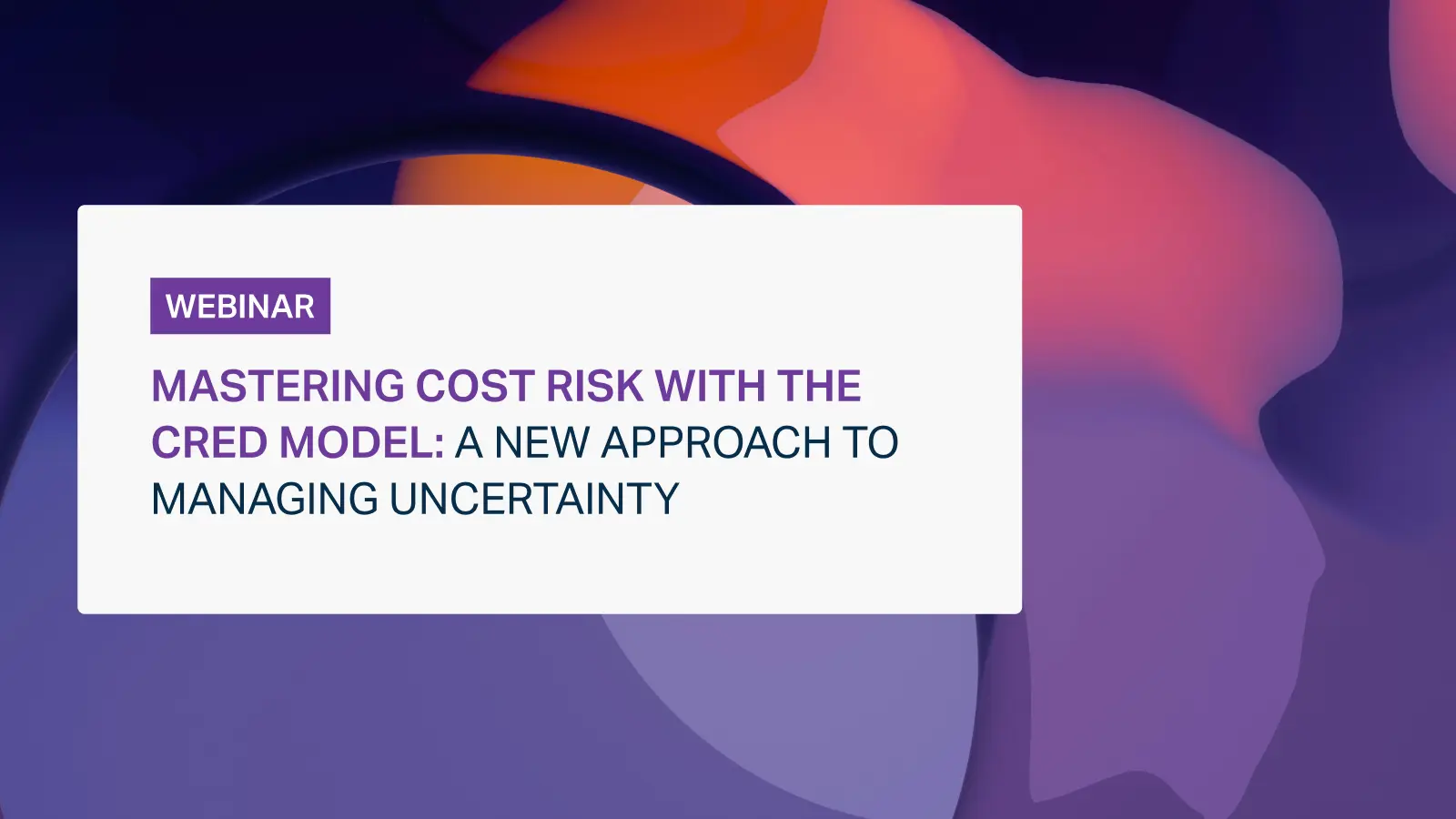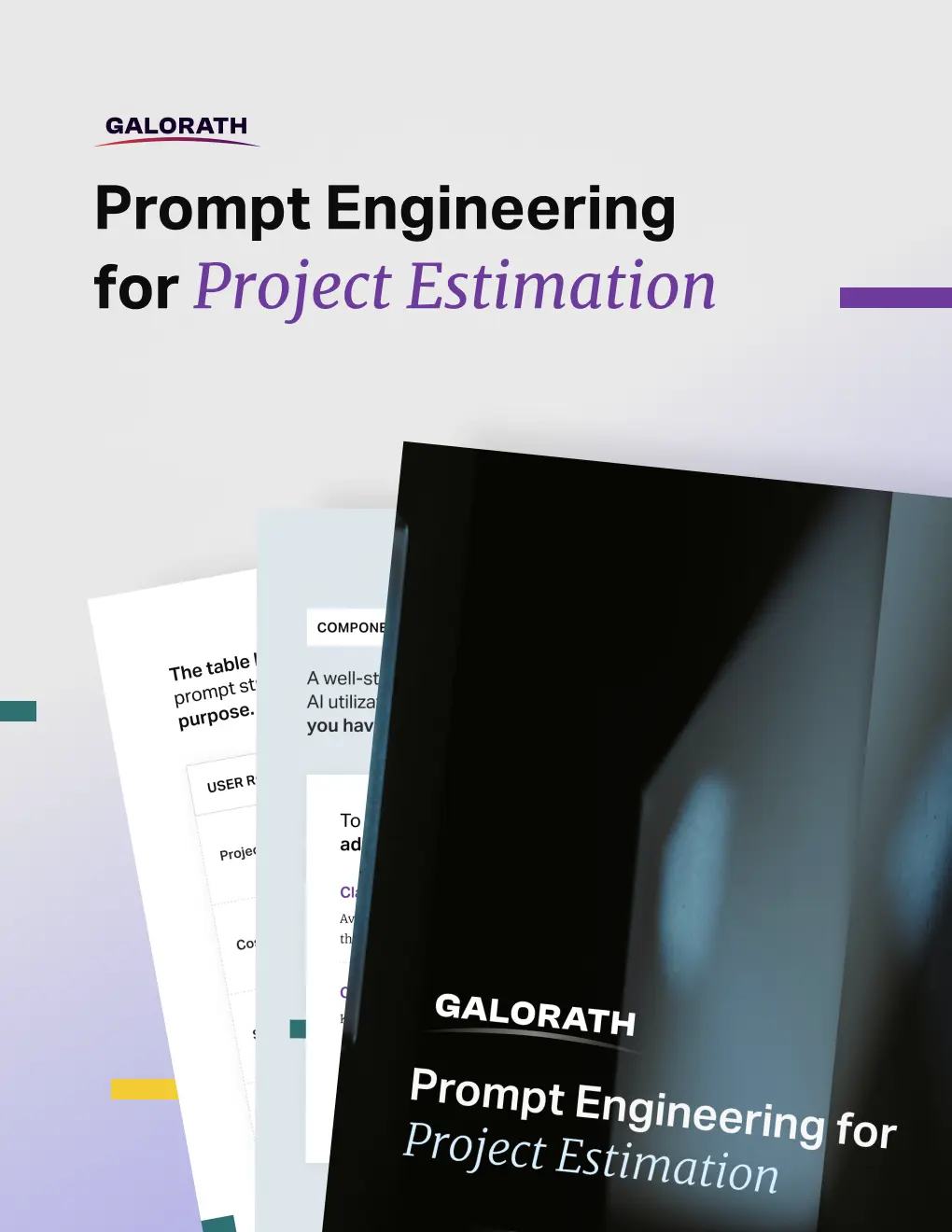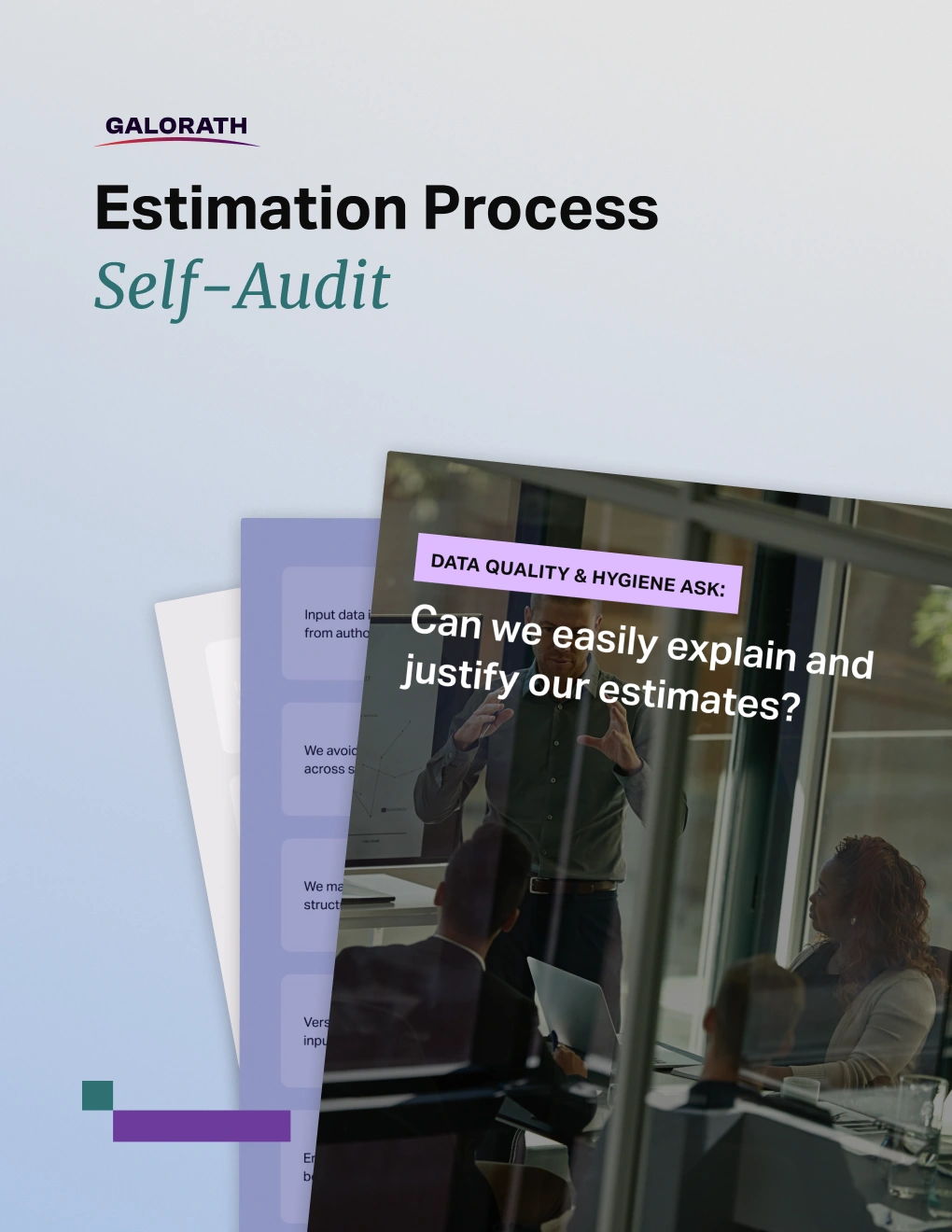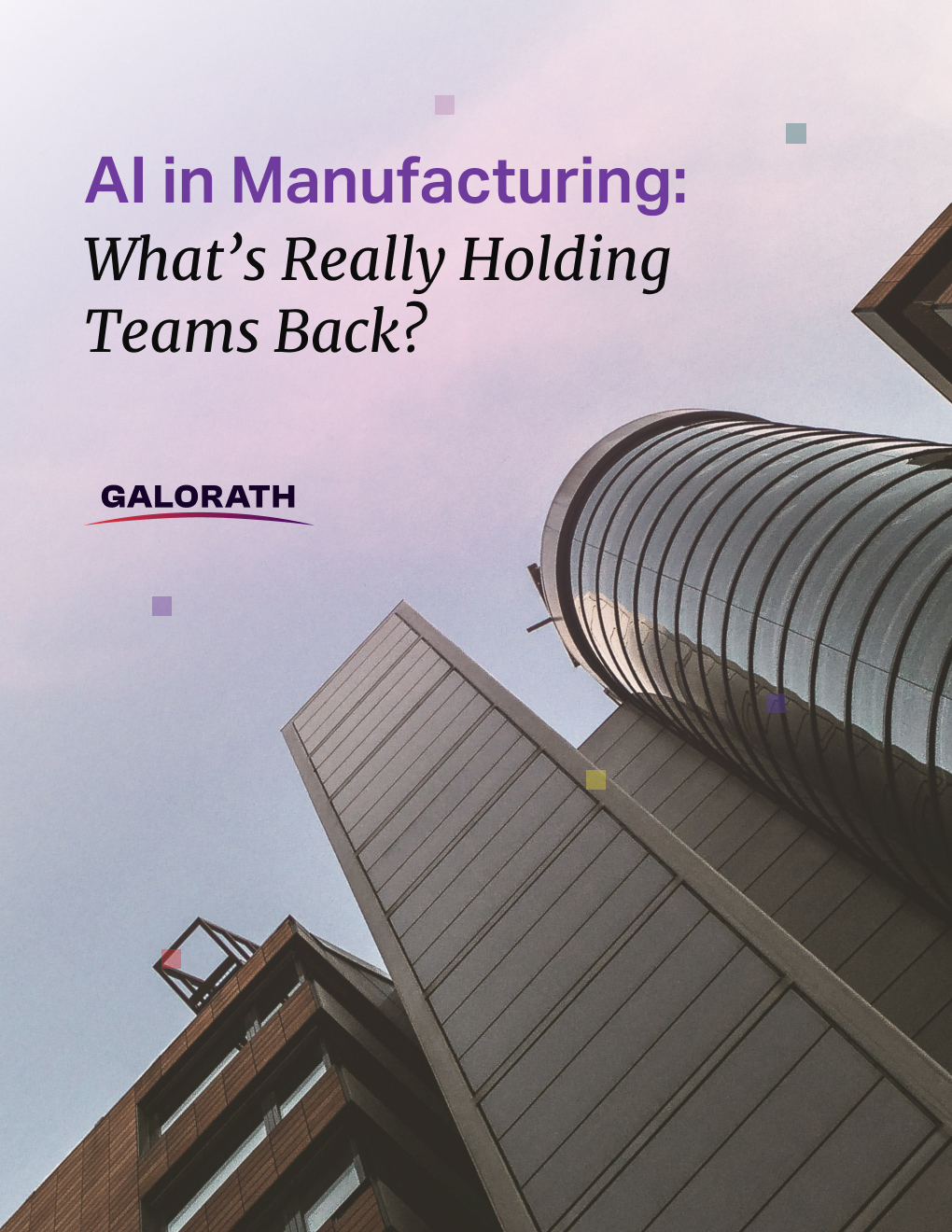Mastering Cost Risk with the CRED Model: A New Approach to Managing Uncertainty

Relying on outdated forecasting methods in 2025 exposes your organization to significant financial risks. CFOs and finance leaders who continue using spreadsheets, historical trends, and static assumptions face critical vulnerabilities. These legacy practices result in budgeting inaccuracies, cost overruns, and strategic miscalculations that directly impact organizational performance. Economic volatility, evolving regulations, and rapid digital transformation intensify these risks, making precise forecasting essential.
A recent study found that 40% of CFOs don’t fully trust the accuracy of their financial data. This lack of confidence contributes directly to budgeting errors, financial overruns, and missed financial targets. A striking example of such forecasting failure is the collapse of Silicon Valley Bank (SVB) in March 2023. A Federal Reserve review identified deficiencies in SVB’s risk management practices, particularly their flawed forecasting models. Bank officers incorrectly anticipated that rising interest rates would stabilize the bank’s financial condition. This serious miscalculation directly contributed to SVB’s failure, highlighting the critical importance of accurate and reliable financial forecasting.
To avoid similar outcomes, CFOs must rethink their approach. Adopting adaptive, AI-driven forecasting solutions is no longer optional; it is the most effective strategy to safeguard financial health, enhance strategic decision-making, and sustain competitive advantage through 2025 and beyond.
The Growing Complexity of Financial Forecasting
Three factors make financial forecasting more difficult than ever:
1. Unpredictable Economic Shifts
Inflation, fluctuating interest rates, and geopolitical tensions create uncertainty. Traditional forecasting models rely on historical data and cannot adjust to economic fluctuations in real time. Finance teams require tools that adapt dynamically to market conditions. Notable examples of economic shifts impacting forecasting accuracy include:
AutoZone’s Revenue Shortfall Due to Inflation and Currency Fluctuations
AutoZone reported lower-than-expected second-quarter revenues due to inflationary pressures and currency rate fluctuations. These factors limited consumer spending, particularly affecting the DIY segment. Net sales decreased by 2% to approximately $3.95 billion, missing analysts’ expectations. reuters.com
Macy’s Store Closures Amid Economic Uncertainties
Macy’s CEO Tony Spring cited economic uncertainties, including ongoing inflation and political changes, as reasons for closing 150 underperforming stores. This decision is part of Macy’s strategy to revitalize its financial performance amidst challenging conditions.
2. Rising Cost Pressures from Digital Transformation
CFOs must balance IT modernization investments with cost control. AI, cloud computing, and cybersecurity are essential but introduce new financial challenges. Many organizations lack forecasting tools capable of accurately modeling these complex expenses. Adopting adaptive, AI-driven forecasting solutions is crucial for safeguarding financial health, improving decision-making, and maintaining a competitive advantage through 2025 and beyond.
3. Tighter Regulatory Oversight
Regulatory requirements for financial reporting and stress testing continue to evolve. In 2025, banks and financial institutions face increased scrutiny. Compliance costs are rising, and CFOs must ensure financial models are both accurate and auditable. This intensified scrutiny is driven by several key developments:
Implementation of Basel III Reforms
The Basel Committee on Banking Supervision finalized Basel III.1 (Basel III Endgame), effective July 1, 2025. The reforms introduce stricter capital requirements and updated approaches to credit risk, necessitating transparent and auditable financial models.
Enhanced Governance and Board Oversight
Regulatory bodies, such as the Australian Prudential Regulation Authority (APRA), introduced governance reforms. These include term limits for directors and mandated board performance reviews, requiring CFOs to strengthen reporting practices.
Increased Emphasis on Ethical Standards
Regulators like the Financial Conduct Authority (FCA) prioritize non-financial compliance, emphasizing ethical workplace behavior and corporate culture. CFOs must demonstrate compliance with comprehensive ethical and regulatory standards.
The Cost of Forecasting Inaccuracy: A Risk CFOs Can’t Ignore
Given these mounting challenges, CFOs must understand the critical importance of forecasting accuracy. Forecasting errors lead directly to significant financial and operational risks, undermining strategic goals and long-term stability. The increasing complexity of financial forecasting demands precision in planning, making it essential for CFOs to address these challenges proactively.
Budget Overruns
One of the most immediate consequences of inaccurate forecasting is budget overruns. Studies show that 45% of major projects exceed their budgets due to poor cost estimation and the limitations of static forecasting tools. Organizations relying on spreadsheets often fail to account for unexpected expenses or market disruptions.
Large capital projects, particularly in banking and finance, frequently experience cost overruns due to digital transformation initiatives. Without real-time cost modeling, these projects suffer from funding shortages, delayed implementation, and diminished returns.
Inaccurate forecasting has led to significant budget overruns in various organizations, particularly during digital transformation projects. Notable examples include:
FBI’s Virtual Case File (VCF) Project
The Federal Bureau of Investigation’s Virtual Case File project, initiated in 2000, aimed to modernize its investigative software. Due to inadequate planning and underestimation of project complexity, the initiative was abandoned in 2005 after nearly $170 million in expenditures, leaving the FBI reliant on outdated systems.
Australian Stock Exchange (ASX) CHESS Replacement
The Australian Stock Exchange embarked on a project to upgrade its Clearing House Electronic Subregister System (CHESS) using blockchain technology. The project faced significant delays and was eventually canceled in 2023 after approximately AUD 170 million had been spent, primarily due to the complexity of the system and underestimation of the project’s scope.
Queensland Health Payroll System
In 2010, Queensland Health implemented a new payroll system that resulted in substantial budget overruns and operational issues. The project, initially budgeted at AUD 6 million, escalated to over AUD 1.2 billion, largely due to inadequate forecasting and planning.
Financial-Reporting Errors and Regulatory Risk
Errors in financial forecasting affect compliance, investor confidence, and strategic planning. Organizations that struggle with accurate forecasting face several risks:
- Regulatory penalties: Industries with strict reporting requirements, such as banking and healthcare, must maintain compliance. Inaccurate forecasting can lead to audits and fines. In 2023, Germany’s financial regulator BaFin fined Deutsche Bank €23 million for multiple regulatory lapses, including shortcomings in internal investigations and mis-selling allegations.
- Missed earnings expectations: Public companies that fail to meet projections may experience stock price declines.
- Delayed decision-making: Poor forecasting results in stalled initiatives and an inability to respond effectively to economic shifts.
Investor Confidence and Market Reputation
Forecasting errors erode investor confidence, making it harder to attract funding and maintain market credibility. Institutional investors rely heavily on precise financial data. When a company repeatedly underestimates costs or overestimates revenue, it creates uncertainty and undermines trust. This uncertainty can lead investors to question the organization’s financial health, potentially leading to reduced investment, declining stock prices, and damage to overall market reputation.
To rebuild investor trust, CFOs can take several specific steps:
- Enhance Transparency: Regularly communicate forecasting methods, assumptions, and uncertainties clearly to investors, promoting transparency and credibility.
- Implement Robust Financial Controls: Strengthen internal financial controls and auditing procedures to detect and correct inaccuracies proactively.
- Adopt Advanced Forecasting Tools: Leverage adaptive, AI-driven forecasting tools to deliver more accurate, dynamic financial insights.
- Proactive Communication: Engage frequently with investors to explain variances promptly, ensuring they understand how management is addressing forecasting discrepancies.
- Demonstrate Consistent Improvements: Regularly showcase progress and improvements in forecasting accuracy, emphasizing continuous improvement efforts.
Strategic Decision-Making and Competitive Disadvantages
Organizations that fail to modernize their forecasting processes risk:
- Overestimating revenue growth, leading to excessive hiring or expansion.
- Underestimating costs, resulting in cash flow shortages and operational disruptions.
- Failing to anticipate economic downturns, making it harder to adjust spending and manage risk.
CFOs must implement AI-driven forecasting tools that improve financial accuracy, reduce risk, and enable data-driven decision-making.
The Shift to AI-Powered Cost Forecasting
Traditional forecasting models are no longer sufficient to handle current financial challenges. To overcome these limitations, organizations are increasingly adopting adaptive, AI-driven forecasting solutions. These advanced tools offer critical advantages:
- Real-time Data Analysis: AI-driven forecasting tools leverage up-to-date data for accurate financial projections, allowing CFOs to make informed, timely decisions.
- Dynamic Adjustments: AI-driven models respond in real-time to market fluctuations, significantly improving forecasting accuracy compared to static, traditional methods.
- Pattern Recognition: AI can identify patterns, trends, and anomalies that human analysts might overlook, providing deeper insights into potential risks and opportunities.
- Enhanced Risk Management: AI-powered scenario planning enables proactive management of financial risks, helping CFOs navigate economic uncertainty effectively.
A significant adoption gap exists, as many organizations struggle to integrate these advanced forecasting tools effectively. Common barriers include reliance on legacy systems, internal resistance to adopting new technologies, and a lack of clarity on implementation processes.
To bridge this gap and facilitate a smooth transition, CFOs should:
- Pilot Programs: Initiate small-scale pilot projects to demonstrate tangible benefits and build internal buy-in.
- Clear Roadmap: Develop a detailed integration roadmap with defined milestones, roles, and timelines to manage expectations and measure progress.
- Training and Support: Invest in comprehensive training programs to equip finance teams with the necessary skills to leverage advanced forecasting tools effectively.
- Continuous Evaluation: Regularly review progress and adjust strategies based on performance feedback, ensuring ongoing alignment with organizational goals.
Investor Confidence, Market Reputation, and the Role of AI
AI-driven forecasting tools offer CFOs a competitive advantage. Unlike static models, AI continuously learns from new financial inputs, market conditions, and risk factors.
How AI Improves Financial Credibility
More Accurate Forecasting: AI-based models detect patterns and trends that traditional forecasting tools miss. This improves financial projections and reduces the likelihood of unexpected shortfalls.
Stronger Risk Management: AI-driven simulations prepare companies for economic downturns and industry disruptions. Investors value organizations that proactively manage risk.
Real-Time Transparency: AI minimizes human error and helps organizations maintain compliance with evolving regulations. Automated anomaly detection prevents costly mistakes.
Data-Driven Decision-Making: AI-driven insights enable CFOs to make more strategic financial decisions. AI-based forecasting reassures investors that projections are based on analytics rather than speculation.
By leveraging AI, companies can transition from reactive financial planning to proactive, data-driven decision-making. AI is no longer an optional enhancement—it is a necessity for securing long-term financial stability.
What CFOs Should Do Next
By 2025, outdated forecasting models will expose companies to unnecessary risks. AI-powered financial planning is no longer a future concept—it is a competitive advantage.
Key Takeaways for CFOs:
- Evaluate current forecasting methods. Do they adjust to real-time economic shifts?
- Assess AI-driven tools that improve financial accuracy and transparency.
- Partner with industry experts to integrate advanced forecasting solutions.
Galorath, a leader in cost, schedule, and risk estimation for more than 45 years, has a platform of solutions tailored to solve industry specific challenges. SEERai®, by Galorath, supports organizations by improving financial forecasting accuracy and strengthening risk management capabilities. Leveraging advanced analytics and generative AI, SEERai helps finance teams better understand and predict costs, identify potential risks, and dynamically adapt to changing market conditions. SEERai provides actionable insights, enabling more precise planning and informed decision-making to enhance financial stability and long-term strategic success.
10 Step Estimation Process Sample Checklist
View our 10 Step Estimating Process Checklist. This checklist should be tuned to the individual company’s needs and suggestions.
Estimating Total Cost of Ownership (TCO)
Find out how you can use Total Cost of Ownership (TCO) model to create an estimate which includes all the costs generated over the useful life of a given application.
Should Cost Analysis
Learn how Should-Cost Analysis can identify savings opportunities and drive cost efficiency in procurement and manufacturing processes.
ROM Estimate: The First Step Towards a Detailed Project Plan
Find out what ROM (rough order of magnitude) estimate is and why is it a crucial element of every project planning cycle.
Software Maintenance Cost
Find out why accurate estimation of software maintenance costs is critical to proper project management, and how it can make up to roughly 75% of the TCO.













